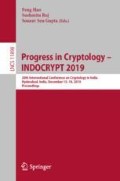Abstract
In an influential work aimed at understanding the communication requirements of secure computation, Feige, Kilian and Naor introduced a minimal model of secure computation (STOC 1994). In that work, among other results, Feige et al. presented a simple protocol for the 2 input AND function. It has remained an intriguing question whether the communication and randomness used in this protocol are optimal. While previous work of Data et al. (CRYPTO 2014) showed that the communication from the two parties with inputs (Alice and Bob) to the third party who gets the output is optimal, the question of optimality for the third message in the protocol – a common reference string shared between Alice and Bob – remained open. In this note we show that in fact, this message (and hence all the randomness used in the protocol) is also optimal in the protocol of Feige et al. This improves on a previous result of Rajan et al. (ISIT 2016), which showed this optimality restricted to protocols where Alice and Bob are deterministic. Further, our result holds even if only a weak secrecy condition is required of the protocol.
The last author is the primary author. The author list is sorted alphabetically.
Access this chapter
Tax calculation will be finalised at checkout
Purchases are for personal use only
Notes
- 1.
This model is also known as the Private Simultaneous Messages (PSM) model, after [11]. The PSM model was originally introduced for a variant of the FKN model with an asymptotically growing number of input parties. Since our focus, similar to [8], is on the setting of 2 input parties, we shall refer to the model as the FKN model.
- 2.
- 3.
They can be derived from AND by negating the inputs and/or the output.
References
Applebaum, B., Holenstein, T., Mishra, M., Shayevitz, O.: The communication complexity of private simultaneous messages, revisited. In: Nielsen, J.B., Rijmen, V. (eds.) EUROCRYPT 2018. LNCS, vol. 10821, pp. 261–286. Springer, Cham (2018). https://doi.org/10.1007/978-3-319-78375-8_9
Chor, B., Kushilevitz, E.: A zero-one law for boolean privacy. SIAM J. Discrete Math. 4(1), 36–47 (1991)
Chor, B., Kushilevitz, E.: A communication-privacy tradeoff for modular addition. Inf. Process. Lett. 45(4), 205–210 (1993)
Cramer, R., Damgård, I., Nielsen, J.B.: Secure Multiparty Computation and Secret Sharing. Cambridge University Press, Cambridge (2015). http://www.cambridge.org/de/academic/subjects/computer-science/cryptography-cryptology-and-coding/secure-multiparty-computation-and-secret-sharing?format=HB&isbn=9781107043053
Damgård, I., Nielsen, J.B., Polychroniadou, A., Raskin, M.: On the communication required for unconditionally secure multiplication. In: Robshaw, M., Katz, J. (eds.) CRYPTO 2016. LNCS, vol. 9815, pp. 459–488. Springer, Heidelberg (2016). https://doi.org/10.1007/978-3-662-53008-5_16
Damgård, I., Nielsen, J.B., Polychroniadou, A., Raskin, M.A.: On the communication required for unconditionally secure multiplication. In: Advances in Cryptology - CRYPTO 2019–39th Annual International Cryptology Conference, Santa Barbara, CA, USA, Proceedings (2019)
Data, D., Prabhakaran, M., Prabhakaran, V.M.: On the communication complexity of secure computation. In: Advances in Cryptology - CRYPTO 2014–34th Annual Cryptology Conference, Santa Barbara, CA, USA, 17–21 August 2014, Proceedings, Part II, pp. 199–216 (2014). https://doi.org/10.1007/978-3-662-44381-1_12. Full version in IEEE Trans. Information Theory, 62(7) 2016
Feige, U., Killian, J., Naor, M.: A minimal model for secure computation (extended abstract). In: Proceedings of the Twenty-sixth Annual ACM Symposium on Theory of Computing, STOC 1994, pp. 554–563. ACM, New York (1994). https://doi.org/10.1145/195058.195408
Franklin, M.K., Yung, M.: Communication complexity of secure computation (extended abstract). In: STOC, pp. 699–710 (1992)
Goldreich, O.: Foundations of Cryptography: Basic Applications. Cambridge University Press, Cambridge (2004)
Ishai, Y., Kushilevitz, E.: Private simultaneous messages protocols with applications. In: Proceedings of the Fifth Israeli Symposium on Theory of Computing and Systems, pp. 174–183, June 1997. https://doi.org/10.1109/ISTCS.1997.595170
Kushilevitz, E.: Privacy and communication complexity. In: 30th Annual Symposium on Foundations of Computer Science, pp. 416–421, October 1989. https://doi.org/10.1109/SFCS.1989.63512
Prabhakaran, M., Sahai, A. (eds.): Secure Multi-Party Computation, Cryptologyand Information Security Series, vol. 10. IOS Press, Amsterdam (2013)
Sundara Rajan S, Rajakrishnan, S., Thangaraj, A., Prabhakaran, V.: Lower bounds and optimal protocols for three-party secure computation. In: 2016 IEEE International Symposium on Information Theory (ISIT), pp. 1361–1365, July 2016. https://doi.org/10.1109/ISIT.2016.7541521
Author information
Authors and Affiliations
Corresponding author
Editor information
Editors and Affiliations
Rights and permissions
Copyright information
© 2019 Springer Nature Switzerland AG
About this paper
Cite this paper
Pillai, S.R.B., Prabhakaran, M., Prabhakaran, V.M., Sridhar, S. (2019). Optimality of a Protocol by Feige-Kilian-Naor for Three-Party Secure Computation. In: Hao, F., Ruj, S., Sen Gupta, S. (eds) Progress in Cryptology – INDOCRYPT 2019. INDOCRYPT 2019. Lecture Notes in Computer Science(), vol 11898. Springer, Cham. https://doi.org/10.1007/978-3-030-35423-7_11
Download citation
DOI: https://doi.org/10.1007/978-3-030-35423-7_11
Published:
Publisher Name: Springer, Cham
Print ISBN: 978-3-030-35422-0
Online ISBN: 978-3-030-35423-7
eBook Packages: Computer ScienceComputer Science (R0)

